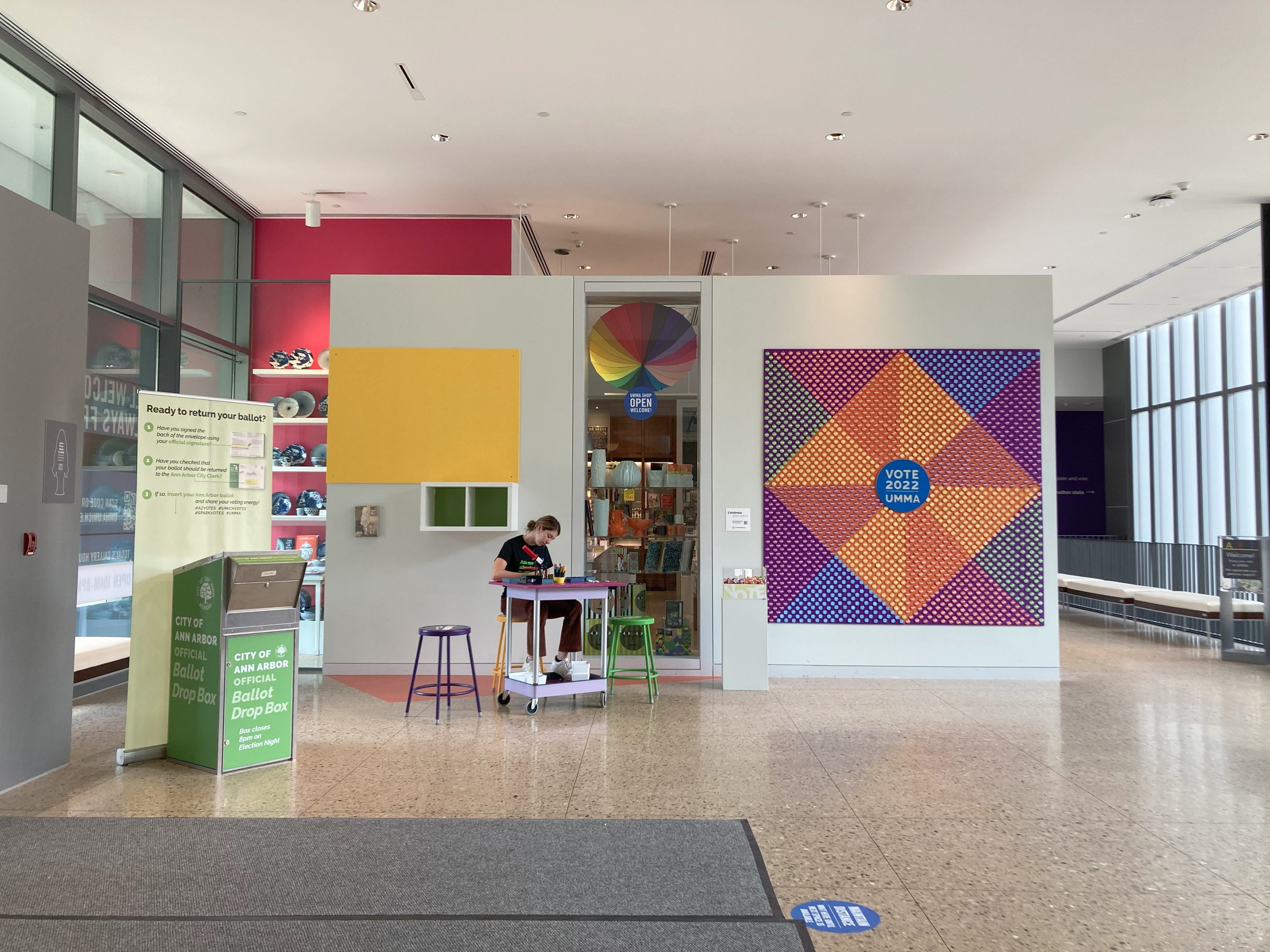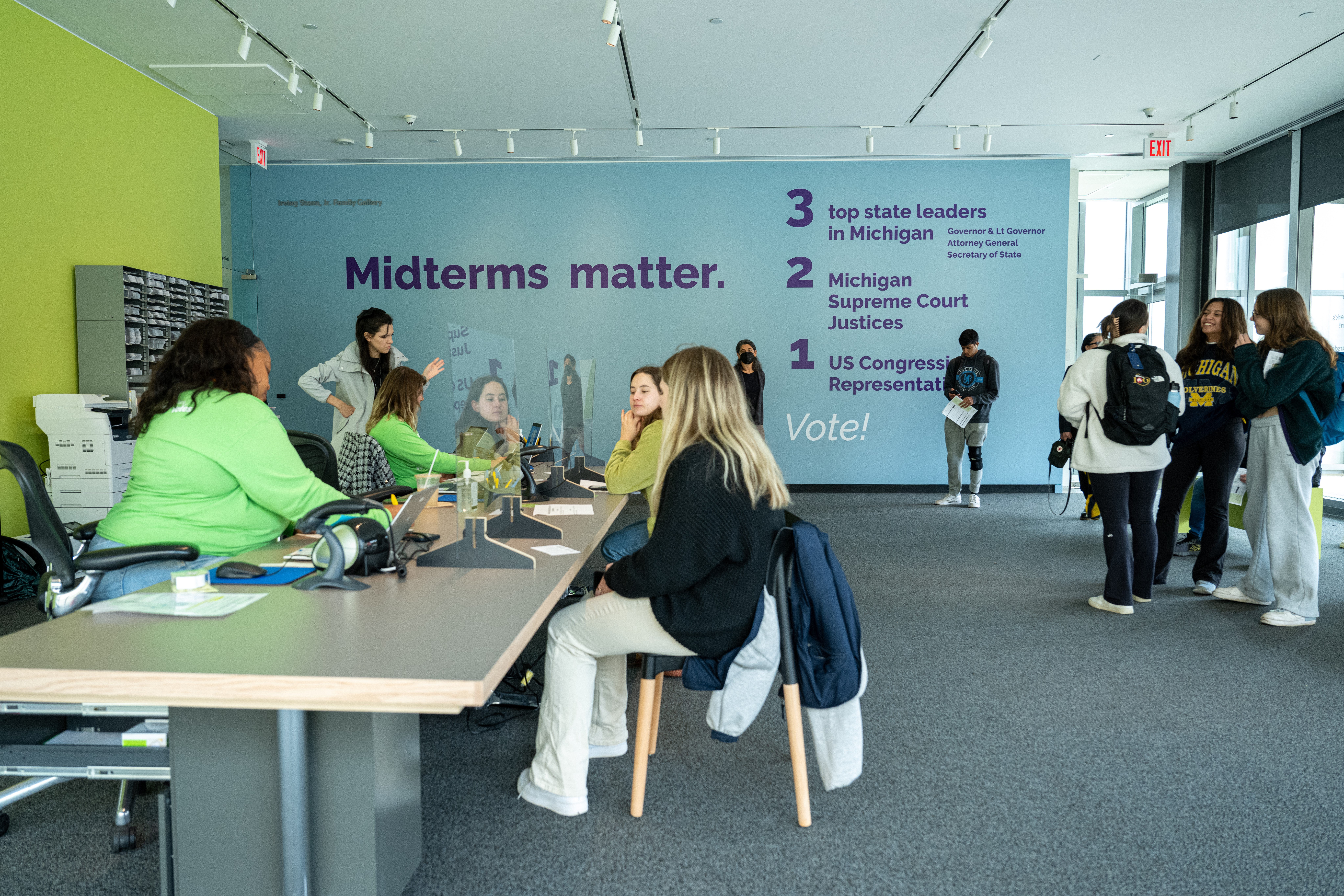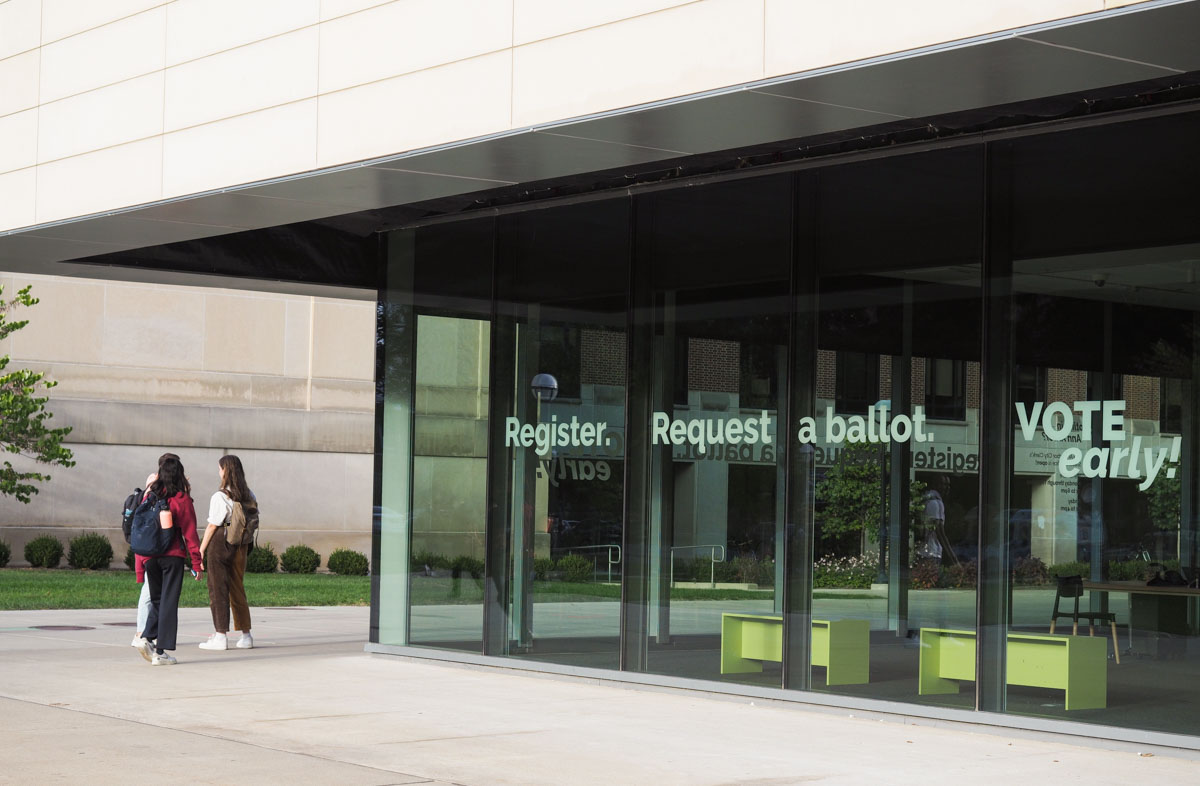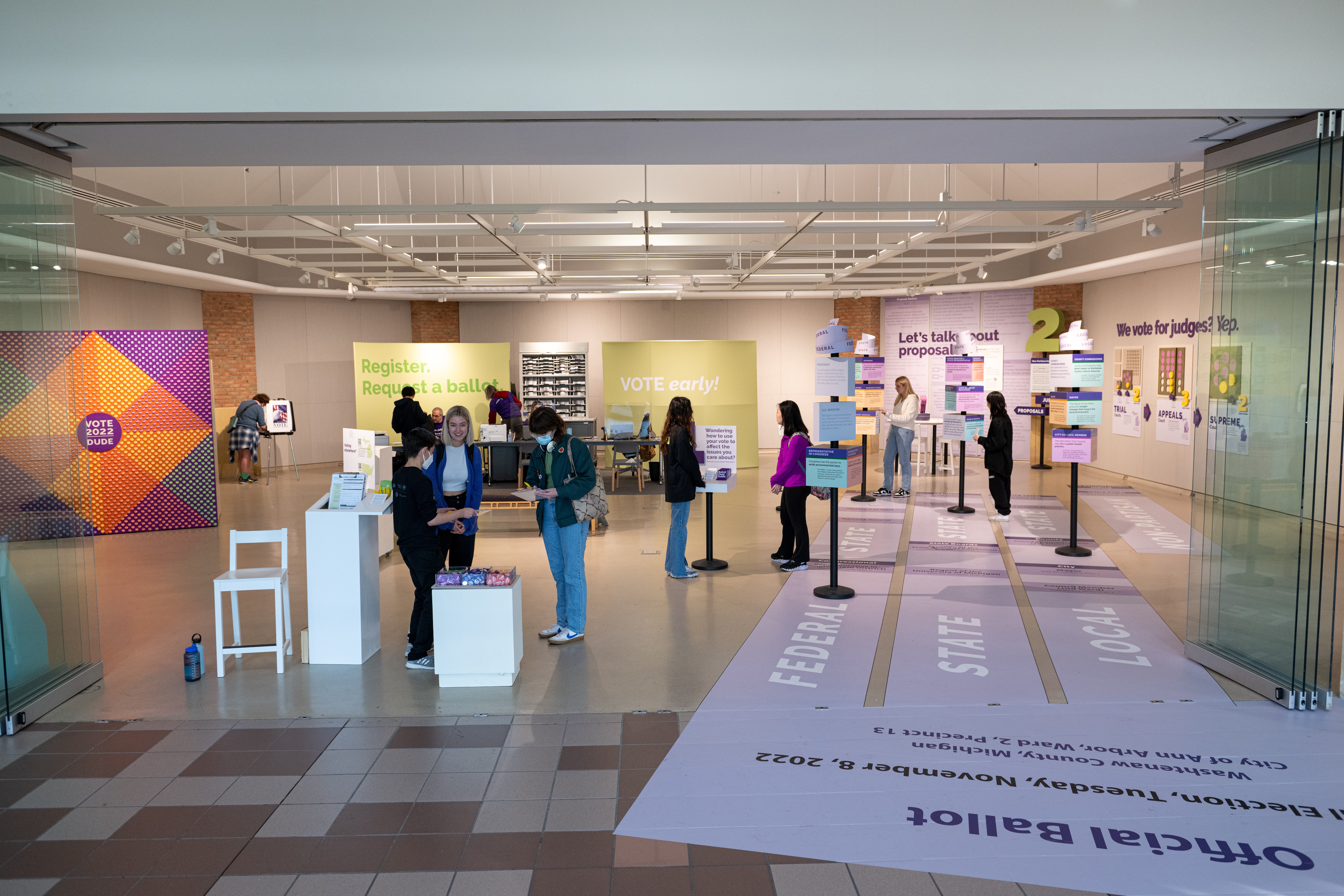UMICH Votes


Ann Arbor, United States
The Action
Michigan voters overwhelmingly approved Proposal 3 in 2018, ushering in same-day voter registration and no-reason absentee voting. This was the catalyst for a unique partnership that transformed gallery space at the University of Michigan Museum of Art (UMMA) into an election hub where students could register to vote, get and drop off ballots, and access non-partisan voting resources. The project was made possible by a close collaboration between UMICH Votes—a coalition of social and civic engagement organizations on campus working to engage and educate student voters in the democratic process—and the Ann Arbor city clerk. The Creative Campus Voting Project, part of UMICH Votes, designed and produced clear educational materials, welcoming spaces, and peer-to-peer experiences to support students throughout the voting process.

Democracy Challenge
Many young voters lack direct access to civic information and support. Research from the Center for Information and Research on Civic Learning and Engagement (CIRCLE) found having access to civic information and spaces that foster political conversation build youth political confidence and may increase voter turnout. College campuses, uniquely positioned to inform and educate students about civic participation before, during, and after elections, can play a vital role in cultivating informed and active youth voters.
Government spaces are often physically uninviting or intimidating and can deter residents, especially young people and marginalized groups, from exercising their democratic rights. By opening a city clerk satellite office in the art museum, the UMICH Votes coalition strategically redirected the power of local government to the campus community. Creative Campus Voting Project made conscious design choices, favoring bright colors and clear instructions over institutional and complicated messaging, to ensure students felt welcome and supported throughout the voting process. Ann Arbor consequently saw record student participation in the 2020 and 2022 elections.

“Our goal was to make it very clear, easy, and welcoming for students to vote,” said Hannah Smotrich, University of Michigan (U-M) professor and co-lead of the Creative Campus Voting Project. “We were able to transform a city clerk’s office, which is traditionally a bureaucratic, institutional space, into something that is beautiful and dynamic. We hope that seeing a space like this inspires students to vote.”
How It Works & How They Did It
The National Study of Learning, Voting, and Engagement found 59.6% of U-M students were registered to vote in the 2014 midterm election, but only 14% cast a ballot. The discrepancy inspired Smotrich and her colleague Stephanie Rowden to establish the Creative Campus Voting Project. Ahead of the 2020 election, they partnered with other campus units and Ann Arbor City Clerk Jacqueline Beaudry, who was already looking for improve Election Day procedures, to establish a satellite office. The museum—specifically its glass-walled Stenn Gallery—was selected as the site for its centrality and the transparent nature of the space. People passing the museum would witness democracy in action.

Rowden and Smotrich, professors at U-M Stamps School of Art & Design, have spent considerable time exploring the role of art and design in demystifying the registration and voting process for new student voters.
“As artists and designers, how can we use our skill set to help students move from intent to action?” Rowden asked. “The more that we understood about student voting behavior and worked with our own students, we realized that there were certain attributes that were really helpful for students.”
Rowden and Smotrich’s ongoing creative action research draws on a combination of behavioral science and qualitative data pulled from the team’s interviews, workshops, and student-driven research. They aim to reduce psychological barriers and provide opportunities to move students from “confusion to clarity and confidence” while incorporating visual elements of delight and creating social connections. To do this, they examined every step in the voting process and assessed students’ informational and emotional needs. The duo discovered the need for psychological reassurance and the importance of cultivating students’ senses of civic duty rather than simply informing them about voting.
How’s It Going?
The National Study of Learning, Voting, and Engagement found 88.5% of U-M students were registered to vote in the 2020 election and 78.1% cast a ballot, up 28.9 and 64.1 percentage points from 2014, respectively. The satellite office registered 5,412 voters and collected 8,501 ballots in 2020. Given that success, the university and city clerk’s office agreed to set up another satellite office at UMMA in 2022.
“As soon as 2020 wrapped up, we were all saying, 'Let's do this again,’” City Clerk Jacqueline Beaudry said.
With the benefit of hindsight and significantly more planning time, Creative Campus Voting Project got to work planning for the 2022 midterm elections. This time, however, they designed a second satellite office in the Duderstadt Gallery on U-M’s North Campus, located a few miles away from the main campus. There would also be a “Ballot Wayfinder” installation that walked students through the process of voting and UMMA programming centered on democracy and civic engagement, such as artist Philippa Hughes’ series of experimental social events that fostered honest conversations among politically diverse groups.

The two U-M city clerk satellite offices again saw significant activity in 2022, handling 3,905 voter registrations and 4,608 ballots, although both figures were down from 2020. Michigan’s youth turnout was still the highest in the nation, in part because state law allows people already in line at polling stations at the 8:00pm closing time to register and vote. Eager young voters did so until 2:00am. On the U-M campus alone, nearly 1,500 students registered and voted on Election Day, leading Washtenaw County, in which the university is located, to announce that the “overwhelming majority” of voter registrations that day were from 18- to 21-year-olds.
“We continue working with Michigan’s colleges and universities and their local clerks to ensure young citizens can conveniently cast their ballot and know how to do so, and I’m thrilled to see data recognizing the impact of our work,” said Michigan Secretary of State Jocelyn Benson.
Rowden, Smotrich, and the UMICH Votes team are already working on plans for 2024, including accommodations for a new Michigan law that mandates early voting to begin at least nine days before Election Day.
“We’re excited to continue developing ways that art and design can expand access to voting and welcome students into the process,” said Smotrich.
Considerations
- Election law and legal challenges: UMICH Votes hinged on election laws passed in 2018 that allowed for same-day voter registration and no-reason absentee voting. These laws faced legal challenges based on concerns about absentee ballot signatures, ballot drop boxes, and mailing absentee ballot applications, among other issues.
- Funding: The UMMA city clerk satellite office was possible thanks to multiple funders, giving Creative Campus Voting Project the resources to intentionally design a space conducive to breaking down barriers to voting. The space also incorporated educational resources, registration support, and auxiliary programming that gave students an augmented civic experience.
Point of Contact
Stephanie Rowden and Hannah Smotrich
Creative Campus Voting Project
[email protected]
[email protected]
creativecampusvoting.org
Who Else Is Trying This?
- Allendale, Michigan, US: GVSU Votes! is a campus coalition at Grand Valley State University focused on voter registration, voter education and dialogue, and voter turnout. In partnership with the Allendale Township clerk, GVSU Votes! hosts a city clerk satellite office that opens three weeks before an election to support the campus community.
- East Lansing, Michigan, US: MSUvote is a non-partisan campus committee at Michigan State University whose mission is to increase the number of registered student voters, to inform and educate students on candidates and issues, and to bolster student participation on Election Day. Through partnerships with the East Lansing and Ingham County clerks’ offices, satellite offices operated across campus for four weeks up to Election Day in 2022.
- Marquette, Michigan, US: In 2020, the Associated Students of Northern Michigan University (ASNMU) partnered with the Marquette city clerk to set up a satellite office where individuals could register to vote as well as request and drop off absentee ballots.